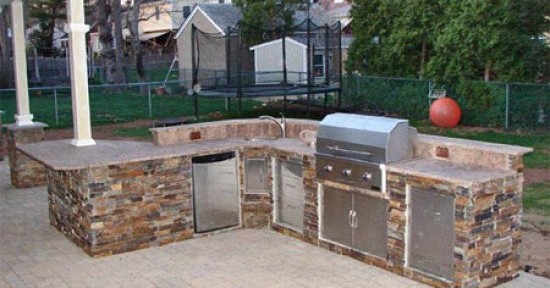A patio is usually a tiled space (outdoor tile patio) that connects the home to the outdoors, and is frequently used for lounging, entertaining guests or holding dinner parties as it allows us to experience indoor comfort while enjoying outdoor recreation. Conversely, it separates the indoors from the outdoors, emphasizing the freedom we feel by going outdoors which is usually stifled by staying indoors, especially with the advent of technological innovations glorifying digital and electrical appliances such as computers and video game consoles. Thus, it is important to create an inviting setting for a patio in order to encourage us to go outdoors more often. Patios are mainly characterized by their flooring together with complementing furniture which contributes to their relaxing features.
Most Popular Outdoor Tile Patio Materials
Whether for aesthetic, financial or practical reasons, some of the most widely used patio flooring materials are tiles, concrete, bricks, wood rounds and wood blocks, wood decks, flagstones or fine textured pavestones and loose aggregate such as pebbles and gravel.
Tiles As Patio Flooring: Outdoor Tile Patio
Tiles come in various sizes, shapes, styles, designs, textures and materials which correspondingly have their own uses, advantages, disadvantages and prices. Due to their diversity, many people are provided with many options to suit their preferences, thereby making tiles a popular choice for patio flooring.
Concrete Patio Flooring
Other options for patio flooring include concrete. Concrete patio flooring is long-lasting. However, it requires maintenance over time as its paint may fade, especially if it is frequently stepped on. It is also slippery when wet and may crack under extremely cold climates. Nevertheless, it can still provide a base for setting tiles or overlaying bricks even when it reaches full depreciation.
Bricks
Many homeowners choose to use bricks for their flexibility as they can blend with various architectural and landscape designs. They can also evoke different moods ranging from coziness to stateliness. For instance, they can be used for a walkway leading to a country house or as flooring for a Spanish courtyard or even for castle walls enclosing a huge garden.
Wood Rounds And Blocks
Wood rounds and blocks, as they are taken from trees, blend well with gardens and create a generally natural ambiance. However, they are susceptible to insect infestations if not treated properly and can eventually rot due to changing weather conditions.
Wood Decks
Wood decks are lightweight and easy to install yet durable. They are also good for warm climates because they do not retain heat. However, while they are aesthetically attractive, their elevated planked surfaces make them susceptible to termite infestations. Aside from that, wood, as we all know, can be consumed by fire.
Flagstones
Flagstones are irregularly shaped slabs of sandstone or limestone and are known for their durability. However, they are considered as one of the most costly patio flooring materials and require the skill of a professional for proper setting. They may also cause accidents due to their jagged surfaces and are therefore not advisable for homes with small children and elderly citizens.
Loose Aggregate
 Loose aggregate are construction materials which serve as temporary floor materials or embellishments to the existing patio flooring. Some widely-used examples are gravel and smooth pebbles. They may also be used to cover whole floor areas such as plant sheds. However, they are not advisable for walkways or patios because they are difficult to walk on and pose as safety hazards as flooring for unstable furniture legs.
Loose aggregate are construction materials which serve as temporary floor materials or embellishments to the existing patio flooring. Some widely-used examples are gravel and smooth pebbles. They may also be used to cover whole floor areas such as plant sheds. However, they are not advisable for walkways or patios because they are difficult to walk on and pose as safety hazards as flooring for unstable furniture legs.
Over all, these outdoor tile patios remain as mere options until we decide which one would best suit our needs.
